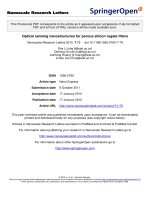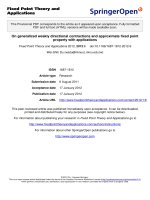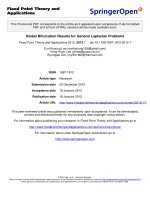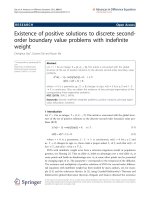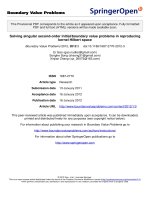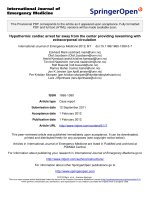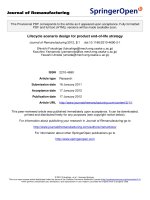Báo cáo toán học: " Tight performance bounds for two-way opportunistic amplify-and-forward wireless relaying networks with TDBC protocols" ppt
Bạn đang xem bản rút gọn của tài liệu. Xem và tải ngay bản đầy đủ của tài liệu tại đây (1.26 MB, 8 trang )
RESEARCH Open Access
Tight performance bounds for two-way
opportunistic amplify-and-forward wireless
relaying networks with TDBC protocols
Xiangdong Jia
1,2,3
, Longxiang Yang
2,3,4*
and Haiyang Fu
2,3
Abstract
Based on amplify-and-forward network coding (AFNC) protocol, the outage probability and ergodic capacity of
two-way network coding opportunistic relaying (TWOR-AFNC) systems are investigated as well as the
corresponding closed-form solutions. For the TWOR-AFNC systems, it is investigated under two scenarios, namely,
the TWOR-AFNC systems without direct link (TWOR-AFNC-Nodir) and the TWOR-AFNC systems with di rect link
(TWOR-AFNC-Dir). First, we investigate TWOR-AFNC-Nodir systems by employing the approximate analysis in high
SNR, and obtain closed-form solutions to the cumulative distribution function (CDF) and the probability density
function (PDF) of the instantaneous end-to-end signal-to-noise ratio (SNR) with very simple expressions. The
derived simple expressions are given by defining an equivalent variable ω
eq-k
(θ), 2 ≤ θ ≤ 3. When θ = 2, the
derived results are the tight lower bounds to CDF and PDF. The sequent simulation demonstrates that the derived
tight lower bounds are also very effective over the entire SNR region though which the results are derived in high
SNR approximation. Then, with the derived tight closed-form lower bound solutions (θ = 2) in TWOR-AFNC-Nodir
systems, we investigate TWOR-AFNC-Dir systems as well as the overall comparison of the outage probability and
the ergodic capacity between the two system models. The comparison analysis performed over path loss model
basis shows that, in urban environment, due to utilizin g the direct link the TWOR-AFNC-Dir outperform
considerably the TWOR-AF-Nodir systems. However, when the value of path loss exponent is relatively large, the
achievable gain is very small and the direct link can be omitted. In this case, the TWOR-AFNC-Dir model can be
displaced by TWOR-AFNC-Nodir model having lower implementation complexity.
Keywords: opportunistic relaying, amplify-and-forward, outage probability, ergodic capacity
1. Introduction
Cooperative diversity is an overwhelming research topic
in wireless networks [1-6]. The notion of cooperative
communications is to enable transmit and receive coop-
eration at user level by forming virtual multiple-input-
multiple-output (MIMO) system, so that the overall per-
formance including power efficiency and communica-
tions reliability can be improved greatly. However, due
to the half-duplex constraint in practical systems, the
advantages of the cooperative diversity come at the
expense of both the spectral eff iciency and the imple-
mentation complexity. Especially, in multi-relay wireless
network with K relays, to achieve the ful l diversity ord er
K + 1 orthogonal wireless channels (slot or frequen cy)
are required, which incurs in the enhancement of imple-
mentation complexity as the perfect time synchroniza-
tion among the relays.
In order to reduce the implementation complexity and
to improve the spectrum effi ciency but still realize the
potential benefits o f multi-relay coope ration, based on
the networ k coding (NC) techniques [7] and the oppor-
tunistic relaying (OR) techniques [8], the two-way net-
work coding opportunistic relay ing (TWOR-NC) has
emerged as a promising solution [9], and instantly
become one of research hot topics in wireless network
fields [10-17]. The basic idea of the TWOR-NC is that,
in multi-relay two-way systems, a round of signals
exchange between two sources consists of two p hases,
* Correspondence:
2
Wireless Communications Key Lab of Jiangsu province, Nanjing University
of Posts and Telecommunications, Nanjing 210003, China
Full list of author information is available at the end of the article
Jia et al. EURASIP Journal on Wireless Communications and Networking 2011, 2011:192
/>© 2011 Jia et al; licensee Springer. Thi s is a n Open Access article distributed under the terms of the Creative Commons Attribution
License ( which permits unrestricted use, distribution, and reproduction in any medium,
provide d the original work is properly cite d.
namely, access phase (AC phase) and broadcast phase
(BC phase). Notice that, according to the different trans-
mission protocols employed, time division broadcast
(TDBC) and multi-access broadcast (MABC), the AC
phase can include one or two sub-slots while the BC
phase only does one slot. In AC phase, two sources
transmit their signals to relays while the relays are lis-
tening state. After receiving the signals from both
sources, the b est relay selection is performed based on a
predefined criterion, which r esults in th at only a best
relay is selected for NC-ing the received signals and
broadcasting the NC-ed signal in BC phase. Thus, after
performing NC on the received signals, the selected best
relay simultaneously broadcasts the NC-ed signa l to two
sources. After receiving the broadcas ted signal from the
best relay, each source can remove the self-interference
from the received signal by taking its own transmitted
signal as prior. Thus, the two sources can obtain the
wished signal. Obviously, the TWOR-NC perfectly inte-
grates the NC and OR te chniques and possesses the
advantages of the two techniques. The TWOR-NC sys-
tems hold the improvement not only on the spectral
efficiency improved by as much as 33 or 50% due to the
employing of NC [7], but also on the implementation
complex ity decreased becau se the perfect time synchro-
nization among the relays is no longer performed.
Currently, there are a few literatures contributing to
TWOR-NC systems [9-17]. In the existing works, based
on the fact that whether the direct link between two
sources is utilized, the TWOR-NC systems can be
grouped into two kinds. The first is th e TWOR-NC sys-
tems in which there is no direct link, which is referred
to as TWOR-NC-Nodir model in the work. On the con-
trary, in the second TWOR-NC systems where the
direct link is utilized perfectly, which is called the
TWOR-NC-Dir model. Oechtering and Boche [9] first
investigated the TWOR-NC-Nodir systems under the
MABC transmission protocol. In the work, the
employed NC scheme was superposition network coding
[4-6]. For the MABC TWOR-NC-Nodir systems, the
updated contribution can be found in [10], where the
decode-and-forward NC (DFNC) was employed. By
comparing the achievable maximum diversity gains of
two TWOR-DFNC-Nodir sytems where the max-min
criterion and maxmum sum-rate criter ion were adopted,
respectively, authors have presente d a intelligent switch-
ing selection criterion wh ich switches between max-min
and maximum sum-rate criterions according to a certain
threshold of signal-to-noise ratio (SNR). In [11], with
the a mplify-and-forward NC ( AFNC) protocol, authors
first obtained the end-to-end rate expressions, R
12
and
R
21
. T hen, with the aim of maximizing the sum rate of
R
12
and R
21
,i.e.,max(R
12
and R
21
), the maximum sum-
rate criterion has been proposed. In [12], besides the
investigation of the TWOR-NC-Nodir system based on
the conventional single best relay selection criterion,
authors have studied the TWOR-NC-Nodir system
where a double best relay selection criterion was
employed. In [13], with the aim of minimzing pairwise
error probability, authors have investigated the TWOR-
DFNC-Nodir systems.
At the same time, compared with the decode-and-for-
ward TWOR [14], TWOR-AFNC is one of the most
attractive protocols due to its operational simpl icity.
Motivated by its practical implementation potential, the
TWOR-AFNC systems have been studied in [15-17]
under different channels and assumptions. In these stu-
dies, the employed system models are still TWOR-
AFNC-Nodir. With the Rayleigh channels, in [16]
authors have pointed out that both the instantaneous
end-to-end SNRs considered as independence random
variables (RVs) in [15] are dependent mutually, and
have presented the exact closed-form expression for
outage probability in integral form as well as the lower
bound. A more overall investigation of the TWOR-
AFNC-Nodir has been presented in [17].
Observing the above summarization, we can find that,
in existing works, the TWOR-NC-Nodir systems have
been investigated widely. For the one with direct link,
TWOR-NC-Dir, the re is no o pen report yet. However,
in practical implementation systems, such direct link
between two sources is always existent. In half-duplex
systems, the employed transmission protocol should be
TDBC when the direct link is exploited. The r eliability
of TWOR-NC systems can be further improved when
such practical existence direct transmission exploited.
For the investigation of TWOR-NC-Dir systems, the
canonical argument line [18] is that we must first obtain
the statistical description of the instantaneous end-to-
end SNRs for the systems without direct link, which
includes cumulative distribution function (CDF), prob-
ability density function (PDF), moment generating func-
tion (MGF), etc. Besides this, the ones of direct link
gains are also required. With these obtained statistical
results of the system without direct link, we can investi-
gate the TWOR-NC-Dir systems by employing some
complicated mathematic manipulations such as (inverse)
Laplace transformation, integral, etc. This mathematic
manipulation requires that the statistical descriptions of
the end-to-end SNRs for the systems without direct link
should be given with simple close d-form expressions.
However, observing the results given in [16,17], we find
that it is difficult to obtain the simple closed-form
expressions of these statistics even if the lower bound
expression (4) in [16] is considered. Motivated by these
observations, the work contributes to a comprehensive
comparison investigation for the TWOR-AFNC. We will
first obtain the closed-form tight lower bound statistical
Jia et al. EURASIP Journal on Wireless Communications and Networking 2011, 2011:192
/>Page 2 of 8
descriptions f or the TWOR-AFNC-Nodir, and then by
using the derived tight lower bound we will study per-
formance of the TWOR-AFNC-Dir systems.
2. TWOR-AFNC system model
We consider TWOR-AFNC quasi-static reciprocal Ray-
leigh fading channel s consisting of two source nodes, S
1
and S
2
, and K relay nodes, R
1
, ,R
K
, where K is the maxi-
mum number of the achievable relays. All the nodes are
equipped with single antenna and operate in half-duplex
mode. The channel coefficient between S
i
and R
k
is
denoted by h
ik
, i =1,2,k = 1,2, ,K,andmodeledas
zero-mean complex Gaussian RV with variances ω
ik
.
The one of the direct link between the two sources is
denoted by bh
0
, where b = 1 denotes that there is direct
link, and b = 0 does that there is no direct link. The
variance of the direct link coefficient is ω
0
. For simpli-
city, we assume that all the channels’ coefficients cap-
ture the path loss, shadow fading, and frequency non-
selective fading due to the rich scattering environment
as well as the transmitting power for signal, and at each
node the received signals are affected by symmetric
Gaussian additive noise w ith identical variance s
2
=1.
That is to say, all nodes transmit signals with unit trans-
mitting power P = 1. Thus, the instantaneous squared
channel strengths obey exponential distrib utions with
hazard rates 1/ω
1k
,1/ω
2k
,and1/ω
0
, respectively,
denoted by g
1k
=|h
1k
|
2
~Υ(1/ω
1k
), g
2k
=|h
2k
|
2
~Υ(1/
ω
2k
), and g
0
=|h
0
|
2
~Υ(1/ω
0
). Due to the TDBC trans-
mission protocol employed, the total time of a round
for the information exchange between two sources is
divided into three slots. In the first two slots, both
sources transmit their signals x
1
and x
2
whereas the
relays are in listening state. Thus, the received signal by
relay R
k
is given by y
k
= h
1k
x
1
+h
2k
x
2
+n
k
. In the l ast slot,
based on the AFNC protocol the relay broadcasts y
k
to
both sources. The received signals by sources S
1
and S
2
are, re spectively, given by y
1
= G
k
h
1k
y
k
+b h
0
x
2
+n
1k
, y
2
=
G
k
h
2k
y
k
+bh
0
x
1
+n
2k
, where
G
k
=1/
(h
1k
)
2
+(h
2k
)
2
+1
(1)
Assuming the maximum ratio c ombining employed,
we can obtain the instanta neous equivalent e nd-to-end
SNRs as follows
γ
2k1
= γ
1
(k)+βγ
0
γ
1k2
= γ
2
(k)+βγ
0
(2)
where g
2k1
and g
1k2
are the receiving SNRs at S
1
and
S
2
, respectively, and
γ
1
(k)=
γ
1k
γ
2k
2γ
1k
+ γ
2k
+ α
γ
2
(k)=
γ
1k
γ
2k
γ
1k
+2γ
2k
+ α
(3)
where a =1.Lettingg(k)=min(g
1
(k),g
2
(k)), we have
the best relay selection criterion
b =argmax
k=1,2, ,K
(γ (k)) γ (b)= max
k=1, ,K
(γ (k))
(4)
This leads to the equivalent instantaneous end-to-end
SNR of the best relay for the TWOR-AFNC systems is
expressed as
γ
T
(b)=
βr
0
+ γ (b)
=
γ (b) β = 0, TWOR - AFNC - Nodir
r
0
+ γ (b) β =1, TWOR-AFNC-Dir
(5)
3. PDF and CDF to the equivalent instantaneous
end-to-end SNR
In this section, we investigate the statistical characteris-
tic of the TWOR-AFNC scheme. According to the state-
ment in Section 1, the statistical description of the
TWOR-AFNC-Nodir systems is required, first ly. Then,
one of TWOR-AFNC-Dir systems can be obtained read-
ily. Thus, we first present the statistical description of
the TWOR-AFNC-Nodir systems.
3.1. Statistical description for TWOR-AFNC-Nodir systems
For the TWOR-AFNC-Nodir channels, we have b =0in
(5). With the ord er statistics [19], the CDF F
g(k)
(g)ofg
(k) = min(g
1
(k),g
2
(k)) is given by
F
γ (k)
(γ )=P(γ (k) <γ)=1-P(γ (k) ≥ γ )
(6)
With the similar approach as the one employed in
[17], the difference g
1
(k)-g
2
(k) is given by
γ
1
(k) −γ
2
(k)=
γ
2k
− γ
1k
(
2γ
1k
+ γ
2k
+ α
)(
γ
1k
+2γ
2k
+ α
)
× γ
1k
γ
2k
(7)
By comparing the values of g
1k
, and g
2k
, we have
γ (k) = min(γ
1
(k), γ
2
(k)) =
γ
1
(k) γ
1k
≥ γ
2k
γ
2
(k) γ
1k
<γ
2k
(8)
Thus, by substituting (3) into (8), the second part of
the right-hand side of (6) can be rewritten i nto two
parts [17]
P(γ (k) >γ)=P(γ
1
(k) ≥ γ ,γ
1k
≥ γ
2k
)+P(γ
2
(k) ≥ γ ,γ
1k
<γ
2k
)
= P
γ
1k
γ
2k
2γ
1k
+ γ
2k
+ α
≥ γ ,γ
1k
≥ γ
2k
+ P
γ
1k
γ
2k
γ
1k
+2γ
2k
+ α
≥ γ ,γ
1k
<γ
2k
= P
γ
2k
≥
γ (2γ
1k
+ a)
γ
1k
− γ
, γ
1k
≥ γ
2k
P
1
(k)
+ P
γ
1k
≥
γ (2γ
2k
+ a)
γ
2k
− γ
, γ
1k
<γ
2k
P
2
(k)
(9)
We first consider the part P
1
(k). Obviously, to obtain
the closed-form solution to P
1
(k), the condition
γ (2γ
1k
+ a)
γ
1k
− γ
≤ γ
1k
is required [16]. The condition can
be rewritten as (g
1k
)
2
-(3g)g
1k
-ga ≥ 0. With the considera-
tion g
1k
≥ 0, we have the condition
Jia et al. EURASIP Journal on Wireless Communications and Networking 2011, 2011:192
/>Page 3 of 8
γ
1k
≥ M =(3γ +
9γ
2
+4γ a)/
2
. This yields that the
component P
1
(k) can be expressed as
P
1
(k)=P
γ
2k
≥
γ (2γ
1k
+ a)
γ
1k
− γ
, γ
1k
≥ γ
2k
= E
γ
1k
⎛
⎜
⎝
γ
1k
γ (2γ
1k
+ a)
γ
1k
− γ
f
γ
2k
(γ )dγ
⎞
⎟
⎠
(10)
where E
g1k
(.) is the expectation operation with respect
to g
1k
.Duetog
2k
=|h
2k
|
2
~Υ(1/ω
2k
), the PDF of g
2k
is
f
γ
2k
(γ )=
1
ω
2k
e
−
γ
ω
2k
. This yields that (10) is rewritten as
P
1
(k)=E
γ
1k
⎛
⎜
⎝
e
−
1
ω
2k
γ (2γ
1k
+ a)
γ
1k
− γ
− e
−
1
ω
2k
γ
1k
⎞
⎟
⎠
(11)
Similarly, since the PDF ofg
1k
is
f
γ
1k
(γ )=
1
ω
1k
e
−
γ
ω
1k
and
γ
1,k
≥ M =(3γ +
9γ
2
+4γ a)/2
, we have
P
1
(k)=
∞
M
⎛
⎜
⎝
e
−
1
ω
2k
γ (2x + a)
x − γ
− e
−
1
ω
2k
x
⎞
⎟
⎠
f
γ
1k
(x)dx =
1
ω
1k
∞
M
⎛
⎜
⎝
e
−
1
ω
2k
γ (2x + a)
x − γ
− e
−
1
ω
2k
x
⎞
⎟
⎠
e
−
x
ω
1k
dx
=
1
ω
1k
∞
M
e
−
1
ω
2k
γ (2x + a)
x − γ
−
1
ω
1k
x
dx
P
11
(k)
−
ω
2k
ω
1k
+ ω
2k
e
−(
1
ω
2k
+
1
ω
1k
)M
P
12
(k)
(12)
In (12), we rewrite the expression of P
11
(k)as
P
11
(k)=
1
ω
1k
∞
M
e
−
2γ
ω
2k
(1+
γ + a/2
x −γ
)−
1
ω
1k
x
dx =
1
ω
1k
e
−
2γ
ω
2k
∞
M
e
−
2γ
ω
2k
γ + a/2
x −γ
−
1
ω
1k
x
dx
(13)
Letting t = x-y and using some manipulations, this
leads to
P
11
(k)=
1
ω
1k
e
−
2γ
ω
2k
∞
M−γ
e
−
2γ
ω
2k
γ + a/2
t
−
1
ω
1k
(γ +t)
dt =
1
ω
1k
e
−(
2γ
ω
2k
+
γ
ω
1k
)
∞
M−γ
e
−
2γ (γ + a/2)
ω
2k
t
−
1
ω
1k
t
dt
(14)
To obtain the closed-form expression of P
11
(k), we
rewrite Equation (14) as
P
11
(k)=
1
ω
1k
e
−(
2γ
ω
2k
+
γ
ω
1k
)
⎛
⎜
⎝
∞
0
e
−
2γ (γ + a/2)
ω
2k
t
−
1
ω
1k
t
dt −
M−γ
0
e
−
2γ (γ + a/2)
ω
2k
t
−
1
ω
1k
t
dt
⎞
⎟
⎠
= e
−γ (
2
ω
2k
+
1
ω
1k
)
⎛
⎜
⎜
⎝
1
ω
1k
∞
0
e
−L
1
ω
2k
t
−
1
ω
1k
t
dt
A
−
1
ω
1k
Q
0
e
−
L
ω
2k
1
t
−
1
ω
1k
t
dt
B
⎞
⎟
⎟
⎠
(15)
where
Q =(γ +
9γ
2
+4γ a)/2
and L =2g(g+a/2).
For the first part A in (15), the closed-form solution can
be readily obtained. By using the equation 3.471.9 in
[20], we have
A =
1
ω
1k
∞
0
e
−L
1
ω
2k
t
−
1
ω
1k
t
dt =2
2γ (γ + a/2)
ω
1k
ω
2k
K
1
⎛
⎝
2
2γ (γ + a/2)
ω
1k
ω
2k
⎞
⎠
(16)
where K
1
(z) is the modified Bessel function. As stated
in [21], in high SNR the modified Bessel function can be
approximated with K
1
(z)~1/z.Thus,for(16),withhigh
SNR approximation we have A~1. For the second
component B given in (15), using the both approxima-
tion e
-t
~1-t and
x + y ∼ 2
√
xy
we have
B ∼
1
ω
1k
Q
0
1 −
L
ω
2k
t
+
t
ω
1k
dt ∼
Q
ω
1k
1 − 2
L
ω
2k
ω
1k
(17)
In high SNR, we have a = s
2
/P~0 [17]. This leads to
M~3g, Q~2g, and L~2g
2
~0. Thus, we have
B ∼
1
ω
1k
2γ − 4γ
2
2
ω
2k
ω
1k
∼
1
ω
1k
2γ
(18)
By using the symmetry between g
1
(k)andg
2
(k)given
in (3) and substituting A, B, (15), (12), and (9) in to (6),
we have the approximate CDF F
g(k)
(g)ofg(k)
F
γ (k)
(γ ) ∼ 1−
⎛
⎜
⎝
e
−γ (
2
ω
2k
+
1
ω
1k
)
1 −
2
ω
1k
γ
+ e
−γ (
1
ω
2k
+
2
ω
1k
)
1 −
2
ω
2k
γ
− e
−(
1
ω
2k
+
1
ω
1k
)3γ
⎞
⎟
⎠
(19)
Observing the expression (19) and substituting
1 −
2
ω
2k
γ ∼ e
−
2
ω
2k
γ
,
1 −
2
ω
2k
γ ∼ e
−
2
ω
2k
γ
, we have
F
γ (k)
(γ ) ∼ 1 −
⎛
⎜
⎝
e
−γ (
2
ω
2k
+
3
ω
1k
)
+ e
−γ (
3
ω
2k
+
2
ω
1k
)
− e
−(
1
ω
2k
+
1
ω
1k
)3γ
⎞
⎟
⎠
(20)
Letting
1
ω
eq−k
(θ)
= θ (
1
ω
2k
+
1
ω
1k
)
,and
F
γ (k)
(γ , θ)=1− e
−θ(
1
ω
2k
+
1
ω
1k
)γ
=1− e
−
1
ω
eq−k
(θ)
γ
,
Equation (20) is bounded by
1 −
⎛
⎜
⎝
e
−(
1
ω
2k
+
1
ω
1k
)2γ
⎞
⎟
⎠
≤ F
γ (k)
(γ , θ ) ≤ 1 −
⎛
⎜
⎝
e
−(
1
ω
2k
+
1
ω
1k
)3γ
⎞
⎟
⎠
(21)
where 2 ≤ θ ≤ 3. By combining (4) and using the order
statistics, we have the approximate CDF F
g(b)
(g, θ)ofg
(b).
F
γ (b)
(γ , θ)=
K
k=1
F
γ (k)
(γ , θ)
(22)
With the very simple expression for the CDF F
g(b)
(g, θ)
of g(b), the PDF f
g(b)
(g, θ)ofg(b) can be readily obtained
by taking the derivative of F
g(b)
( g, θ) with respect to g,
and is given approximately by
f
γ (b)
(γ )=
K
k=1
1
ω
eq−k
(θ)
e
−
γ
ω
eq−k
(θ)
K
i=0
(−1)
i
b
1
+···+b
K
=k
b
k
=0
e
−γ
K
m=1
b
m
ω
eq−m
(θ)
(23)
where b
1
, ,b
k
a binary sequence is whose elements
assume the value of zero or one.
Jia et al. EURASIP Journal on Wireless Communications and Networking 2011, 2011:192
/>Page 4 of 8
3.2. Statistical description for TWOR-AFNC-Dir systems
In the above section, the CDF and PDF of g(b)are
achieved with very simple closed-form expressions,
whichmakeitiseasytoinvestigateTWOR-AFNC-Dir
systems. In (5), since that g(b)andg
0
are indepen dent,
the MGF of g
T
(b)=g(b)+g
0
is given by
M
γ
T
(s)=M
γ
(b)
(s).M
γ
0
(s)
. Using the definition of MGF
given by M
g
(s)=E(e
-sy
), where E (x) is the expectation
operation, we have the MGF of g
0
given by
M
r
0
(s)=
1
ω
0
(s +1/ω
0
)
(24)
Similarly, with (23) and the definition of MGF we have
the MGF of g(b) given by
M
γ (b)
(s, θ )=
K
k=1
1
ω
eq−k
(θ)
K
i=0
(−1)
i
b
1
+···+b
K
=k
b
k
=0
s +
1
ω
eq−k
(θ)
+
K
m=1
b
m
ω
eq−m
(θ)
−1
(25)
Thus, with (24) and (25) we have the MGF
M
γ
T
(s)
given
M
γ
T
(s, θ)=
1
ω
0
K
k=1
1
ω
eq−k
(θ)
K
i=0
(−1)
i
b
1
+ +b
K
=k
b
k
=0
s +
1
ω
0
)
−1
s +
1
ω
eq−k
(θ)
+
K
m=1
b
m
ω
eq−m
(θ)
−
1
(26)
To find the PDF of g
T
,weusetheinverseLaplace
transform defined by
f
γ
T
(γ , θ)=L
−1
{M
γ
T
(s, θ )}
,where
L
−1
{x}
is the inverse Laplace transform operator. This
leads to
f
γ
T
(γ , θ )=
1
ω
0
K
k=1
1
ω
eq−k
(θ)
K−1
i=0
(−1)
i+1
b
1
+···+b
K
=k
b
k
=0
1
ω
eq−k
(θ)
+
K
m=1
b
m
ω
eq−m
(θ)
−
1
ω
0
−1
⎛
⎜
⎝
e
−(
1
ω
eq−k
(θ)
+
K
m=1
b
m
ω
eq−m
(θ)
)
− e
−
1
ω
0
γ
⎞
⎟
⎠
(27)
Taking the integral of (27) with respect to g,the
approximate CDF of g
T
is given by
F
γ
T
(γ , θ )=1−
1
ω
0
K
k=1
1
ω
eq−k
(θ)
K−1
i=0
(−1)
i+1
×
b
1
+···+b
K
=k
b
k
=0
1
ω
eq−k
(θ)
+
K
m=1
b
m
ω
eq−m
(θ)
−
1
ω
0
−1
⎛
⎜
⎝
(
1
ω
eq−k
(θ)
+
K
m=1
b
m
ω
eq−m
(θ)
)
−1
e
−γ (
1
ω
eq−k
(θ)
+
K
m=1
b
m
ω
eq−m
(θ)
)
− ω
0
e
−
1
ω
0
γ
⎞
⎟
⎠
(28)
3.3. Ergodic capacity for TWOR-AFNC systems
The capacity of the TWOR-AFNC-Nodir systems is
defined as C(g(b )) = log(1+g(b)). This leads to the ergo-
dic capacity [22]
C =
∞
0
C(γ (b))f
γ (b)
(γ )dγ
(29)
Substituting f
g(b)
(g) given in (23) into (29) and follow-
ing4.337.1in[20],wehavetheergodiccapacityofthe
considered TWOR-AFNC-Nodir systems as follows
C(θ)=
1
ln 2
K
k=1
1
ω
eq−k
(θ)
K−1
i=0
(−1)
i
b
1
+···+b
K
=k
b
k
=0
1
1
ω
eq−k
(θ)
+
K
m=1
b
m
ω
eq−m
(θ)
e
⎛
⎝
1
ω
eq−k
(θ)
+
K
m=1
b
m
ω
eq−m
(θ)
⎞
⎠
ε
1
1
ω
eq−k
(θ)
+
K
m=1
b
m
ω
eq−m
(θ)
(30)
where ε
1
(m) is the exponential integral function
defined by
ε
1
(m)=
∞
1
e
−tm
t
dt
.
Similar to (30), we can obtain t he ergodic capacity of
TWOR-AFNC-Dir systems.
C(θ)=
1
ln 2
1
ω
0
K
k=1
1
ω
eq−k
(θ)
K−1
i=0
(−1)
i+1
b
1
+···+b
K
=k
b
k
=0
1
ω
eq−k
(θ)
+
K
m=1
b
m
ω
eq−m
(θ)
−
1
ω
0
−1
×
⎛
⎜
⎜
⎜
⎜
⎝
e
⎛
⎝
1
ω
eq−k
(θ)
+
K
m=1
b
m
ω
eq−m
(θ)
⎞
⎠
1
ω
eq−k
(θ)
+
K
m=1
b
m
ω
eq−m
(θ)
ε
1
1
ω
eq−k
(θ)
+
K
m=1
b
m
ω
eq−m
(θ)
− ω
0
e
1
ω
0
E
1
1
ω
0
⎞
⎟
⎟
⎟
⎟
⎠
(31)
3.4. Outage probabilities for TWOR-AFNC systems
The outage probability of TWO-AFNC systems is
defined as the probability that the instantaneous end-to-
end SNR falls bellow a certain predefined threshold μ
0
.
For TWOR-AFNC-Nodir and TWOR-AFNC-Dir sys-
tems, the outage probabilities are, respectively, given by
P
Nodir
out
(μ
0
, θ )=P(γ (b) <μ
0
)=F
γ (b)
(μ
0
, θ )
(32)
P
Dir
out
(μ
0
, θ )=P(γ
T
<μ
0
)=F
γ
T
(μ
0
, θ )
(33)
4. Simulation analysis
With the above investigation, the simulations are pre-
sented in this section. In the simulation, we employ a
path loss model [23], which includes path loss, show
fading, and frequency non-selective fading because the
rich scattering environment is given by
h
mn
= c/
d
p
mn
,
where h
mn
and d
mn
, respectively, denote the link gain
and the distance from node m to n, c is attenuation
constan t, and p is the path loss exponent. In genera l, in
urban or suburban environment, the path loss exponent
is a li ttle greater tha n 3. Without loss of generality, we
assume that the distance between two sources is nor-
malized to 1, the normalized distance from S
1
to relay
R
k
is d
1k
, and the one from S
2
to R
k
is d
2k
.Itisalso
assumed that al l the relay s are close together and the
inter-relay distances are enough small. This assumption
is commonly used in the context of cooperative diversity
systems and guarantees equivalent average variances:
ω
1k
and ω
2k
for links S
1
->R
k
and S
2
->R
k
.Thus,we
have ω
0
= c
2
, ω
1k
= ω
0
(d
1k
)
-p
,andω
2k
= ω
0
(1-d
1k
)
-p
,
where k = 1, ,K , K is the maximum of the achievable
relays.
By taking ω
0
= 0.33, K = 6, the path loss exponent p =
3,andspectrumefficiencyR
0
=1,inFigure1,wefirst
consider the TWOR-AFNC-Nodir systems (without
direct link) and co mpare the outage performance
between the derived results and the one obtained in [16]
under s ymme tric channels (d
1k
= 0 .5). At the same time,
we also present the actual accurate simulation results
denoted by “o” in Figure 1. From the presented results,
we can find clearly that the derived result is the tight
Jia et al. EURASIP Journal on Wireless Communications and Networking 2011, 2011:192
/>Page 5 of 8
lower bound when θ = 2, and is the upper bound when
θ = 3. In practice, θ = 3 denotes the high SNR approxi-
mate case where the two instantaneous end-to-end
SNRs ar e independent [15]. For the lower bound, in low
SNR region, the d erived result and the one ( 4) given in
[16] enjoy approximately equal outage probability. In
large high SNR region, the deriv ed result is closer to the
actual simulation and is tighter lower bound than the
one (4) in [16]. Moreover, the gap between t he derived
result and the actual simulation becomes smaller and
smaller with the increasing SNR. Howeve r, observing
the result presented in [16], we can find that the gap
holds a constant, approximately. It is also observed that,
for the considered symmetric channels, the result g iven
in [16] have larger error, but the derived result matches
with the simulations exactly, especially in high SNR
regions. The observation indicates that the derived
result is more perfect than the result (4) given in [16]
when the channels are symmetric. Thus, by taking θ =
2, we investigate the tight lower bound of the outage
probabilities for TWOR-AFNC-Dir systems (with direct
link), and the results are denoted by “ ∇” in Figure 1.
The result indicates that when the direct link is utilized
the TWOR-AFNC-Dir can obtain approximately 3 dB
gain of SNR at 10
-10
of outage probability under the
symmetric channels.
Figures 2 and 3 are the comparison of the ergodic
capacity versus K. Due to the lower bounds of both PDF
and CDF employed, the ergodic capacity is t he upper
bound.FromFigure2,itisobservedthatwhenthe
direct link is exploited the TWOR-AFNC systems obtain
obvious improvement on ergodic capacity. The achiev-
able gain of ergodic capacity is decreasing with the
number of relays when the number of relays is small.
However, when the number of relays is relatively large,
the gain of ergodic capacity is co nstant, approximately.
Take the symmetric channels as example, at SNR = 10
dB, the gain of the upper bound of ergodic capacity is
0.6 when the number of relays is 2, but it is 0.3 when
the number of relays is greater than 6.
Figure 3 is the comparison of ergodic capacity
between the symmetric channels and asymmetric chan-
nels for TWOR-AFNC systems with a nd without direct
link cases. It is observed that, in the both TWOR-AFNC
systems, the ergodic capacities of symmetric channels
are granter than the one of asymmetric channels. When
the number of relays is small, the gain of ergodic capa-
city achieved by symmetric channels over the asym-
metric one is increasing with K. However, when K is
relatively large (K > 6), it equals to a constant,
approximately.
In Figures 4 and 5, we investigate the effect of path
loss exponent on the system performance. In the simu-
lation, only the symmetric c hannels are considered and
the values of ω
1k
and ω
2k
are constant, i.e., the distance
d
1k
=0.5,ω
1k
= ω
2k
= c
2
=0.33,andω
0
= c
2
×(0.5)
p
.
This leads to that the corresponding performance of the
TWOR-AFNC-Nodir systems should be constant. How-
ever, for the systems with direct link, it should be chan-
ging with the path loss exponent p.FromFigures4and
5,wecanfindthattheperformanceimprovement
obtained in the systems with direct are considerable
when the value of path loss exponent is relativel y small.
For example, in urban environment (p = 3), the maxi-
mum ergodic capacity gain is 0.29 and the SNR gain is
2.5 at 10
-10
of outage probab ility. However, the curves
of both outage probability and ergodic capacity are very
close to the curves of the systems without direct link
when the value of the path loss exponent is grater than
5, which yields that the performance gain obtained in
TWOR-AFNC-Dir systems is very small and can be
Figure 1 Comparison of outage probabi lity versus SNR for
TWOR-AFNC systems (K =6,p =3,R
0
=1,d
1k
= 0.5).
Figure 2 Comparison of tight upper bound of ergodic capacity
versus number of relays between TWOR-AFNC-Dir and TWOR-
AFNC-Nodir (K = 10, p =3,d
1k
= 0.5).
Jia et al. EURASIP Journal on Wireless Communications and Networking 2011, 2011:192
/>Page 6 of 8
omitted. The observed result indicates that when the
value o f path loss exponent is relatively large, the d irect
link can be omitted, which yields that the complexity of
systems is degraded greatl y. On the contrary, we should
consider the direct l ink. Besi des this, in Figure 5(b) it is
observed that the gain of ergodic capacity obtained in
direct link systems is increasing with SNR when the
value of SNR is small (SNR < 20 dB). When it is large
(SNR ≥ 20dB), the achieved gain is a constant.
5. Conclusion
Through the high SNR approximation, we first obtain
the closed-form analytical solutions to CDF and PDF of
the end-to-end SNR for TWOR-AF-Nodir systems, and
present the corresponding tight lower bound. Though
the tight lower bounds are obtained in high SNR
(a) TWOR-AFNC-Dir s
y
stems (b) TWOR-AFNC-Nodir s
y
stems
Figure 3 Comparison of tight upper bound of ergodic capacity versus number of relays between symmetric channels and asymmetric
channels d
1k
= 0.3 for TWOR-AFNC-Dir and TWOR-AFNC-Nodir, respectively (K = 10, p =3). (a) TWOR-AFNC-Dir systems; (b) TWOR-AFNC-
Nodir systems.
Figure 4 Effect of p ath loss exponent on outage probability
for TWOR-AFNC systems under symmetric channels (K =6).
(a) Effect on er
g
odic capacit
y
(b) Er
g
odic capacit
y
g
ain of TWOR-AFNC-Dir s
y
stems
Figure 5 Effect of path loss exponent on ergodic capacity for TWOR-AFNC systems under symmetric channels (K =6). (a) Effect on
ergodic capacity; (b) ergodic capacity gain of TWOR-AFNC-Dir systems.
Jia et al. EURASIP Journal on Wireless Communications and Networking 2011, 2011:192
/>Page 7 of 8
approximation, the sequent simulations demonstrate
that the high SNR approximation results are also effec-
tive over the entire SNR region. Especially, the results
are given with very simple closed-form expressions,
which are significant for the investigation of the
TWOR-AFNC systems having direct link between two
sources. With the approximate lower bounds to PDF
and CDF for TWOR-AF-Nodir systems, the outage per-
formance and the ergodic capacity for TWOR-AF-Dir
systems are investigated comprehensively. The presented
simulation indicates that, in urban environment, by uti-
lizing the direct link t he TWOR-AF systems can obtain
the considerable improvement on the performance.
However, when the value of path loss exponent is large
relatively, the TWOR-AF-Dir model can be displaced
with the TWOR-AF-Nodir model having lower imple-
mentation complexity.
Abbreviations
AC phase: access phase; AFNC: amplify-and-forward NC; BC phase: broadcast
phase; CDF: cumulative distribution function; DFNC: decode-and-forward NC;
MABC: multi-access broadcast; MGF: moment generating function; MIMO:
multiple-input-multiple-output; MRC: maximum ratio combining; NC:
network coding; OR: opportunistic relaying; PDF: probability density function;
RV: random variable; SNR: signal-to-noise ratio; TDBC: time division broadcast;
TWOR-NC: two-way network coding opportunistic relaying; TWOR-NC-Dir:
TWOR-NC systems where there is direct link between two sources; TWOR-
NC-Nodir: TWOR-NC systems where there is no direct link between two
sources.
Acknowledgements
The study was supported by the Natural Science Foundation of China under
Grant 61071090 and 61171093, by the Postgraduate Innovation Program of
Scientific Research of Jiangsu Province under Grant CX10B-184Z and
CXZZ11_0388, and by the project 11KJA510001 and PAPD.
Author details
1
College of Mathematics and Information Science, Northwest Normal
University, Lanzhou 730070, China
2
Wireless Communications Key Lab of
Jiangsu province, Nanjing University of Posts and Telecommunications,
Nanjing 210003, China
3
Key Lab of Broadband Wireless Communication and
Sensor Network Technology (Nanjing University of Posts and
Telecommunications), Ministry of Education, Nanjing 210003, China
4
National
Mobile Communications Research Lab, Southeast University, Nanjing 210096,
China
Competing interests
The authors declare that they have no competing interests.
Received: 14 April 2011 Accepted: 1 December 2011
Published: 1 December 2011
References
1. JN Laneman, DNC Tse, GW Wornell, Cooperative diversity in wireless
networks: efficient protocols and outage behavior. IEEE Trans Inf Theory.
50(11), 3062–3080 (2004)
2. SS Ikki, MH Ahmed, On the performance of cooperative-diversity networks
with the Nth best-relay selection scheme. IEEE Trans Commun. 58(11),
3062–3069 (2010)
3. G de Oliveira Brante, D Souza, M Pellenz, Cooperative partial retransmission
scheme in incremental decode-and-forward relaying. Eurasip Journal on
Wireless Communications and Networking 2011(1), 1–13 (2011).
doi:10.1186/1687-1499-2011-1
4. XD Jia, H Fu, L Yang, L Zhao, Superposition coding cooperative relaying
communications: outage performance analysis. Int J Commun Syst. 24(3),
384–397 (2011). doi:10.1002/dac.1160
5. J Xiangdong, Y Longxiang, Diversity-and-multiplexing tradeoff and
throughput of superposition coding relaying strategy. J Electron (China).
27(2), 166–175 (2010). doi:10.1007/s11767-010-0316-y
6. J Xiangdong, F Haiyang, Research on the outage exponent of superposition
coding relaying with only relay-to-source channel state feedback. Chin J
Electron (CJE). 20(1), 161–164 (2011)
7. T Koike-Akino, P Popovski, V Tarokh, Optimized constellations for two-way
wireless relaying with physical network coding. IEEE J Sel Areas Commun.
27(5), 773–787 (2009)
8. A Bletsas, A Khisti, DP Reed, A Lippman, A simple cooperative diversity
method based on network path selection. IEEE J Sel Areas Commun. 24(3),
659–672 (2006)
9. TJ Oechtering, H Boche, Bidirectional regenerative half-duplex relaying
using relay selection. IEEE Trans Wirel Commun. 7(5), 1879–1888 (2008)
10. I Krikidis, Relay selection for two-way relay channels with MABC DF: a
diversity perspective. IEEE Trans Veh Technol. 59(9), 4620–4628 (2010)
11. H Kyu-Sung, K Young-Chai, MS Alouini, Performance bounds for two-way
amplify-and-forward relaying based on relay path selection. in IEEE 69th
Proc Vehicular Technology Conference, 2009. VTC Spring 2009 1–5 (2009)
12. L Yonghui, RHY Louie, B Vucetic, Relay selection with network coding in
two-way relay channels. IEEE Trans Veh Technol. 59(9), 4489–4499
13. QF Zhou, L Yonghui, FCM Lau, B Vucetic, Decode-and-forward two-way
relaying with network coding and opportunistic relay selection. IEEE Trans
Commun. 58(11), 3070–3076 (2010)
14. Z Chen, H Liu, W Wang, A novel decoding-and-forward scheme with joint
modulation for two-way relay channel. IEEE Commun Lett. 14(12),
1149–1151 (2010)
15. J Zheng, B Bai, Y Li, Outage-optimal opportunistic relaying for two-way
amplify and forward relay channel. Electron Lett. 46(8), 595–597 (2010).
doi:10.1049/el.2010.2803
16. H Guo, JH Ge, Outage probability of two-way opportunistic amplify-and-
forward relaying. Electron Lett.
46(13), 918–919 (2010). doi:10.1049/
el.2010.1315
17. M Ju, I-M Kim, Relay selection with ANC and TDBC protocols in
bidirectional relay networks. IEEE Trans Commun. 58(12), 3500–3511 (2010)
18. M Torabi, D Haccoun, W Ajib, Performance analysis of cooperative diversity
with relay selection over non-identically distributed links. IET Commun. 4(5),
596–605 (2010). doi:10.1049/iet-com.2009.0508
19. HA David, HN Nagaraja, Order Statistics, 3rd edn. (Wiley, New York, 2003)
20. IS Gradshteyn, IM Ryzhik, Table of Integrals, Series, and Products, 7th edn.
(Academic, San Diego, CA, 2007)
21. C Xu, S Ting-wai, QF Zhou, FCM Lau, High-SNR analysis of opportunistic
relaying based on the maximum harmonic mean selection criterion. IEEE
Signal Process Lett. 17(8), 719–722 (2010)
22. L Sungeun, H Myeongsu, H Daesik, Average SNR and ergodic capacity
analysis for opportunistic DF relaying with outage over rayleigh fading
channels. IEEE Trans Wirel Commun. 8(6), 2807–2812 (2009)
23. D Zhiguo, KK Leung, DL Goeckel, D Towsley, On the study of network
coding with diversity. IEEE Trans Wirel Commun. 8(3), 1247–1259 (2009)
doi:10.1186/1687-1499-2011-192
Cite this article as: Jia et al.: Tight performance bounds for two-w ay
opportunistic amplify-and-forward wireless relaying networks with
TDBC protocols. EURASIP Journal on Wireless Communications and
Networking 2011 2011:192.
Jia et al. EURASIP Journal on Wireless Communications and Networking 2011, 2011:192
/>Page 8 of 8
